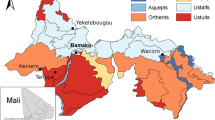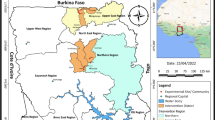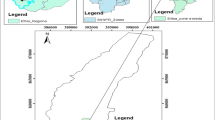Abstract
Despite the importance of Allanblackia floribunda as a multipurpose tree grown in south east Nigeria, where small scale farmers retain some trees on their farm land for soil rejuvenation, there is a dearth of research information on intercropping the tree species with grain crops in the region. Field experiments were conducted in 2016 and 2017 cropping seasons in south eastern Nigeria to evaluate the effect of 2–3 years old Allanblackia floribunda alley systems on soil chemical properties and growth and yield of maize and mungbean. The experimental design was a factorial arranged in a randomized complete block design (RCBD). Standard labouratory procedures were used for the soil chemical properties while data on growth and yield were collected for maize and mungbean. All the data collected in the experiments were subjected to analysis of variance using GenStat Release 12.1. Before the commencement of first year double cropping and after two years of cropping, soil samples were collected from the respective plots and analysed for soil chemical properties. The maize experiment had two maize spatial arrangements grown between the tree alleys and in monocrop plots. After the harvest of maize, mungbean was introduced at two plant spacings of 30 × 20 cm and 20 × 20 cm. Soil phosphorus was significantly increased in Allanblackia tree alley than in the control by 55.6%. Soil pH, phosphorus, potassium, magnesium and calcium increased significantly with tree age. Maize under sole cropping intercepted higher photosynthetically active radiation than maize under alley cropping. Double row maize in both cropping systems produced taller plants in 2017 and greater leaf area index in both years than single row maize at 10 and 12 weeks after planting (WAP). Alley cropping with Allanblackia floribunda tree significantly reduced maize seed yield relative to double row maize in sole cropping. The wider spacing of 30 × 20 cm of mungbean significantly reduced average seed yield in alley cropping but increased number of pods per plant in the monocrop in 2017. In contrast, the 20 × 20 cm mungbean spacing in alley cropping produced comparable high seed yield as sole cropping in either of the two spacings.
Similar content being viewed by others
References
Abuzar MR, Sadozai GU, Baloch MS, Baloch AA, Shah IH, Javaid T, Hussain N (2011) Effect of plant population densities on yield of maize. J Animal Plant Sci 21(4):692–695
Akbar M, Khan MI (2002) Effects of row orientationon yield and yield components of corn. Pakistan J Agric Res 17(2):186–189
Anjum MS, Ahmed ZI, Rauf CA (2006) Effect of Rhizobium inoculation and nitrogen fertilizer on yield and yield components of mungbean. Int J Agric Biol 8(2):238–240
Ano AO, Agwu JA (2005) Effect of animal manures on selected soil chemical properties. Nigerian J Soil Sci 15:14–19
Anwar F, Latif S, Przybylski R, Sultana B, Ashraf M (2007) Chemical composition and antioxidant activity of seeds of different cultivars of mungbean. J Food Sci S: (Sensory and Nutritive Qualities of Food) 72:S503–S510
Asaah E, Tchoundjeu Z, Ngahane W, Tsobeng A, Kouodiekong L, Jamnadass R, Simons A (2011) Allanblackia floribunda: a new oil tree crop for Africa: amenability to grafting. New Forests 41:389–398. https://doi.org/10.1007/s11056-010-9230-z
AVRDC (2012) Mung bean. Asian Vegetable Research and Development Center - The World Vegetation Center. Available at http://www.avrdc.org/index.php?id=416&no_cache=1&sword_list%5B%5D=bean
Awais M, Aftab W, Muhammad UB, Muhammad HUR, Muhammad ASR, Ashfaq A, Muhammad FS, Hafiz MH, Muhammad M, Umer S, Muhammad NA, Fahad S, Wajid N (2017) Nitrogen and plant population change radiation capture and utilization capacity of sunflower in semi-arid environment. Environ Sci Pollution Res 24:17511–17525
Barrios E, Sileshi GW, Shepherd K, Sinclair F (2012) Agroforestry and soil health: Linking trees, soil biota and ecosystem services. In: Wall DH (ed) Soil ecology and ecosystem services. Oxford University Press, Oxford, pp 315–330
Bayala J, Van Noordwijk M, Lusiana B, Ni’matul K, Teklehaimanot Z, Ouedraogo SJ (2008) Separating the tree–soil–crop interactions in agroforestry parkland systems in Saponé (Burkina Faso) using WaNuLCAS. In: Jose S, Gordon AM (eds) Towards agroforestry design - an ecological approach. Advances in agroforestry. Springer, Netherlands, pp 285–297
Bayala J, Sanou J, Teklehaimanot Z, Sinclair F (2015) Adaptation of crops to partial shade in mixed cropping systems. In: Black C, Wilson J, Ong CK (eds) Tree-crop interactions: agroforestry in a changing climate. CABI, UK, pp 309–325
Buss C, Tissari J (2010) Allanblackia– an ingredient for poverty reduction? International platform. Available at: http://www.allanblackiapartners.org/sites/default/files/Allanblackiaaningredient%20for%20poverty%20reduction.pdf
Cia A, Xu M, Wang B, Shang W, Liang G, Hou E, Lou Y (2019) Manure acts as a better fertilizer for increasing yield than synthetic fertilizer does by improving soil fertility. Soil Tillage Res 189:168–175
Crockett SL (2015) Allanblackia Oil: Phytochemistry and Use as a Functional Food. Int J MolSci 16:22333–22349
Dufour L, Metay A, Talbot G, Dupraz C (2012) Assessing light competition for cereal production in temperate agroforestry systems using experimentation and crop modelling. J Agron Crop Sci 199(3):217–227
Folarin OM, Oreniyi AS, Oladipo OG (2017) Physicochemical and kinetics parameters of Allanblackia floribunda seed oil and some of its metal carboxylates. SciInt 5:56–62
Gao L, Xu H, Bi H, Xi W, Bao B, Wang X et al (2013) Intercropping competition between apple trees and crops in agroforestry systems on the loess plateau of China. PLoS ONE 8(7):e70739
Garre S, Dupraz C, Hiel MP, Frayret CB, Lassons L (2017) Impact of spatio-temporal shade dynamics on wheat growth and yield, perspectives for temperate agroforestry. Eur J Agron 82:60–70
GenStat (2009) GenStat Twelfth edition, Release 12.1 Lawes Agricultural Trust Rothamstead Experimental Station, UK.
Huang CD, Liu QQ, Li XL, Zhang CC (2019) Effect of intercropping on maize grain yield and yield components. J Integr Agric 18(8):1690–1700
Ikoh AO, Etokoren UE, Peleyeju KO, Udoh EI (2017) Agronomic response of fluted pumpkin to organomineral fertilizers in rainforest ecology of southeastern Nigeria. Nigeria J Crop Sci 4:7–14
Iwuagwu MC, Okpara DA, Mouneke CC (2017) Growth and yield responses of cocoyam to organic wastes in the humid agro-ecological zone of south eastern Nigeria. J Plant Soil Int 16(1):1–11
Iwuagwu MC, Okpara DA, Ogbonna NC, Okechukwu C (2019) Soil chemical properties and nutrient composition of cocoyam grown in organically fertilized soil. Commun Soil Sci Plant Anal. https://doi.org/10.1080/00103624.2019.1648491
Khan MA, Naveed K, Ali K, Ahmad B, Jan S (2012) Impact of mungbean-maize intercropping on growth and yield of mungbean. Pak J Weed Sci Res 18(2):191–200
Koyejo AO, Okpara DA, Onyeonagu CC, Eteng EU (2020) Effects of climatic variations on leaf litter production in A. floribunda agroforestry system in South-East Nigeria. Nigerian J Soil Sci 30(2):42–48
Mbah CN (2008) Contributions of organic amendments to exchangeable potassium present and soil nitrate concentration in an ultisol and their effect in maize grain yield. J Tropical Agric Food, Environ Ext 7:206–210
Mantino A, Volpi I, Micci M, Pecchioni G, Bosco S, Dragoni F, Mele M, Ragaglin G (2020) Effect of tree presence and soil characteristic on soybean yield ad quality in an innovative alley cropping system. Agronomy 10(1):52. https://doi.org/10.3390/agronomy10010052
Mondal MMA, Puteh AB, Malek MA, Ismail MR, Rafil MY, Latif MA (2012) Seed yield of mungbean (Vigna radiata (L) Wilczek) in relation to growth and developmental aspects. Sci World J. https://doi.org/10.1100/2012/425168
Morales-Ruiz A, Loeza-Corte JM, Díaz-López E, Morales-Rosales EJ, Franco-Mora O, Mariezcurrena-Berasaín MD, Estrada-Campuzano G (2016) Efficiency on the use of radiation and corn yield under three densities of sowing. Int J Agron. https://doi.org/10.1155/2016/6959708
Motsara MR, Roy RN (2008) Guide to laboratory establishment for plant nutrient analysis. FAO Fertil Plant Anal Bull 19:1–219
Okpara DA (2000) Effect of time of introduction of components crops and of fertilizer nitrogen application on maize and vegetable cowpea grown in mixtures under the humid tropical conditions. J Tropical Agric Food, Environ Ext 2:65–75
Okpara DA, Omaliko CPU (1995) Productivity of yam bean / yam intercropping. Indian J AgricSci 65:880–882
Okpara DA, Awurum AN, Okeke AI (2004) Effect of planting schedule and density on cowpea/ maize intercropping in south eastern Nigeria. J Sustain Tropical Agric Res 11:59–67
Okpara DA, Nwofia G, Chukwuekezie G, Ojikpong T (2009) Productivity of cocoyam / cowpea intercrop as influenced by cowpea growth habit. Niger Agric J 40:73–81
Oliveira VR, Silva PSL, Oliveira PL, Siqueira F, Dantas IM, Negreirrev MZ (2016) Corn-tree proximity effects in agroforestry experiments. Caatinga, Mossoró 29(3):648–655
Onuh MO, Ohazurike NC, Ijezie A (2011) Effects of mungbean/melon/maize intercrop on the growth and yield of mungbean (Vigna radiata (L.) Wilczek) cultivated in Owerri Rainforest Area. World J AgricSci 7:161–165
Orwa C, Mutua A, Kindt R, Jamnadass R, Anthony S (2009) Allanblackia floribunda http://apps.worldagroforestry.org/treedb/AFTPDFS/Allanblackia_floribunda.PDF
Pye-Smith C (2009) Seeds of Hope: A public-private partnership to domesticate a native tree, Allanblackia, is transforming lives in rural Africa. World Agroforestry Centre, Nairobi. Available at http://www.worldagroforestry.org/downloads/Publications/PDFs/B16262.PDF
Rachaputi RC, Chauhan Y, Douglas C, Martin W, Krosch S, Agius P, King K (2015) Physiological basis of yield variation in response to row spacing and plant density of mungbean grown in subtropical environments. Field Crop Res 183:14–22
Reynolds PE, Simpson JA, Thevathasan NV, Gordon AM (2007) Effects of tree competition on corn and soybean photosynthesis, growth, and yield in a temperate tree-based agroforestry intercropping system in southern Ontario, Canada. Ecol Eng 29:362–371
Sahilemedin S, Taye B (2000) Procedure for soil and plant Analysis. Addis Ababa: Nat Soil Res 3(6):470–479
Scott AG (2015) Physiological evaluation and root morphological differences associated with novel drought tolerant corn (Zea mays, L) hybrids. Unpublished M Sc. Thesis, University of Tennessee, 2015. Available at https://trace.tennessee.edu/utk_gradthes/3605
SDN (2016) Allanblackia report. A report by Stakeholder Democracy Network (SDN). Available at: https://www.stakeholderdemocracy.org/wp-content/uploads/2016/10/Allanblackia-Report.pdf
Smethurst PJ, Huth NI, Masikati P, Sileshi GW, Akinnifesi FK, Wilson J, Sinclair F (2017) Accurate crop yield predictions from modelling tree-crop interaction in gliricidia-maize agroforestry. Agric Syst 155:70–77. https://doi.org/10.1016/j.agsy.2017.04.008
Sungthongwises K, Sornpha W (2020) Increasing Yield of Vigna radiata (L.) cv. Chai Nat 72 with suitable sowing spacing. Asian J Crop Sci 12:170–174
van Reeuwijk LP (2002) Editor-procedure for soil analysis, 6th ed., International Soil Reference and Information Centre, Wageningen, The Netherlands
Waniale A, Wanyera N, Talwana H (2013) Morphological and agronomic traits variations for mungbeanvariety selection and improvement in Uganda. Afr Crop Sci J 22(2):123–136
Willey RW (1979) Intercropping, its importance and research needs 1. Competion and yield advantages. Field Crops Abstr 32:1–10
Wu Y, Zhu Z (1997) Temperate agroforestry in China. In: Gordon AM, Newman SM (eds) Temperate agroforestry systems. CAB International Press, Wallingford, UK, pp 149–179
Xia HY, Zhao JH, Sun JH, Bao XG, Christie P, Zhang FS, Li L (2013) Dynamics of root length and distribution and shoot biomass of maize as affected by intercropping with different companion crops and phosphorus application rates. Field Crop Res 150:52–62
Xu H, Bi H, Gao L, Yun L (2019) Alley cropping increases land use efficiency and economic profitability across the combination cultivation period. Agronomy 9:34. https://doi.org/10.3390/agronomy9010034
Author information
Authors and Affiliations
Corresponding author
Additional information
Publisher's Note
Springer Nature remains neutral with regard to jurisdictional claims in published maps and institutional affiliations.
Rights and permissions
About this article
Cite this article
Koyejo, A.O., Okpara, D.A. & Agugo, B.A.C. Effect of alley cropping on soil, maize and mungbean grown under different maize spatial arrangements and mungbean spacings in south east Nigeria. Agroforest Syst 97, 1337–1346 (2023). https://doi.org/10.1007/s10457-021-00635-5
Received:
Accepted:
Published:
Issue Date:
DOI: https://doi.org/10.1007/s10457-021-00635-5




